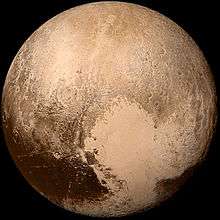2010 FX86
| Discovery[1] | |
|---|---|
| Discovered by | Observers S. S. Sheppard, A. Udalski, I. Soszynski |
| Discovery site | Las Campanas Observatory, Chile |
| Discovery date | 17 March 2010 |
| Designations | |
| MPC designation | 2010 FX86 |
| Cubewano[2] | |
| Orbital characteristics[3] | |
| Epoch 13 January 2016 (JD 2457400.5) | |
| Uncertainty parameter 4 | |
| Observation arc | 797 days (2.18 yr) |
| Aphelion | 49.705 AU (7.4358 Tm) |
| Perihelion | 44.326 AU (6.6311 Tm) |
| 47.015 AU (7.0333 Tm) | |
| Eccentricity | 0.057203 |
| 322.38 yr (117749 d) | |
| 290.653° | |
| 0° 0m 11.006s /day | |
| Inclination | 25.1781° |
| 310.822° | |
| 348.142° | |
| Earth MOID | 43.3123 AU (6.47943 Tm) |
| Jupiter MOID | 39.21 AU (5.866 Tm) |
| Physical characteristics | |
| Dimensions | 230–598 km (diameter) |
| 15.80 h (0.658 d) | |
Sidereal rotation period | 15.8 hr[3] |
| 0.09 (assumed)[4] | |
| 4.3,[1] 4.2[3] | |
|
| |
2010 FX86, also written 2010 FX86, is a relatively bright classical Kuiper belt object[3][5] with an absolute magnitude of 4.3.[1] It is estimated to be about 600 kilometres (370 mi) in diameter.[4] Astronomer Mike Brown lists it as likely a dwarf planet.[4]
References
- 1 2 3 "MPEC 2010-G57 : 2010 FX86". Minorplanetcenter.org. Retrieved 2014-06-13.
- ↑ "IAU Minor Planet Center". Minorplanetcenter.net. 2010-03-17. Retrieved 2014-06-13.
- 1 2 3 4 Alan Chamberlin. "JPL Small-Body Database Browser". Ssd.jpl.nasa.gov. Retrieved 31 March 2016.
- 1 2 3 Michael E. Brown. "How many dwarf planets are there in the outer solar system? (updates daily)". California Institute of Technology. Archived from the original on 2011-10-18. Retrieved 2011-08-25.
- ↑ "MPEC 2011-F17 : 2010 FX86". Minorplanetcenter.org. Retrieved 2014-06-13.
External links
- 2010 FX86 at the JPL Small-Body Database

This article is issued from Wikipedia - version of the 9/21/2016. The text is available under the Creative Commons Attribution/Share Alike but additional terms may apply for the media files.
_(cropped).jpg)
